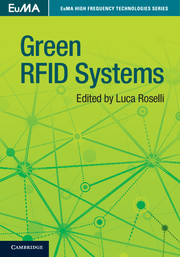Book contents
- Frontmatter
- Contents
- List of contributors
- Introduction
- 1 Context analysis
- 2 RFID background
- 3 Energy scavenging and storage for RFID systems
- 4 Technologies for RFID sensors and sensor tags
- 5 Unconventional RFID systems
- 6 Integrating tiny RFID- and NFC-based sensors with the Internet
- 7 Materials for substrates
- 8 Organic conductors and semiconductors: recent achievements and modeling
- 9 RFID enabling new solutions
- 10 Energy-efficient off-body communication using textile antennas
- Index
- References
9 - RFID enabling new solutions
Published online by Cambridge University Press: 05 October 2014
- Frontmatter
- Contents
- List of contributors
- Introduction
- 1 Context analysis
- 2 RFID background
- 3 Energy scavenging and storage for RFID systems
- 4 Technologies for RFID sensors and sensor tags
- 5 Unconventional RFID systems
- 6 Integrating tiny RFID- and NFC-based sensors with the Internet
- 7 Materials for substrates
- 8 Organic conductors and semiconductors: recent achievements and modeling
- 9 RFID enabling new solutions
- 10 Energy-efficient off-body communication using textile antennas
- Index
- References
Summary
Introduction
The short-range wireless transmission of sensor information finds application in several fields ranging from the monitoring of biological parameters in medicine [1–6], to the measurements of mechanical quantities in industrial applications [7–10] and robot guidance [11]. In the last years several technologies have been developed to this purpose, and the emerging one is based on the Radio Frequency IDentification (RFID) concept [12]. This is due to the convergence of several new ideas and approaches like RF energy harvesting [13, 14], RF carrier re-use, the load modulation method, and organic [15–23] and inkjet-printed [24–29] electronics. RF energy harvesting and RF carrier re-use, for example, make possible battery-less (i.e. passive) RFID sensors that can operate for years without any maintenance.
A detailed description of a common RFID system is given in Chapter 2; however, it is worth recalling that it is usually composed of: a reader (or interrogator), that sends an interrogation signal to an RFID tag; a tag (or transponder) which identifies the object with a code, basically implemented by an IC and an antenna; and a host computer that codes and encodes the data from the reader. Moreover, a wireless connection to a global network can be provided [30]. Figure 9.1 shows a block diagram of a typical RFID system, including the tag, the reader, and the host computer connected to a global network.
- Type
- Chapter
- Information
- Green RFID Systems , pp. 228 - 247Publisher: Cambridge University PressPrint publication year: 2014



